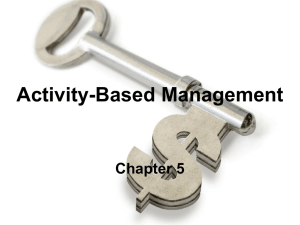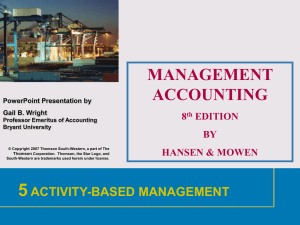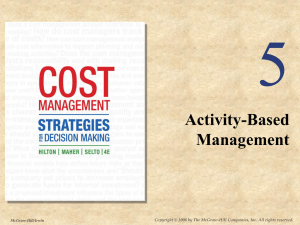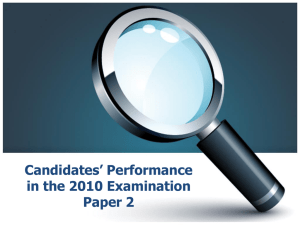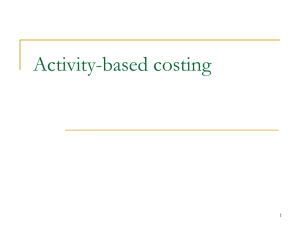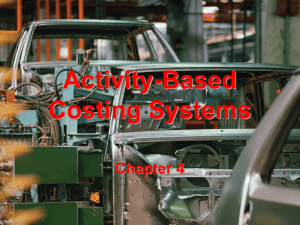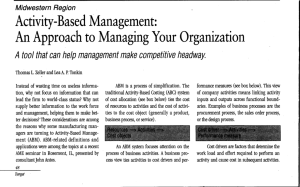Chapter 5 PPT
advertisement
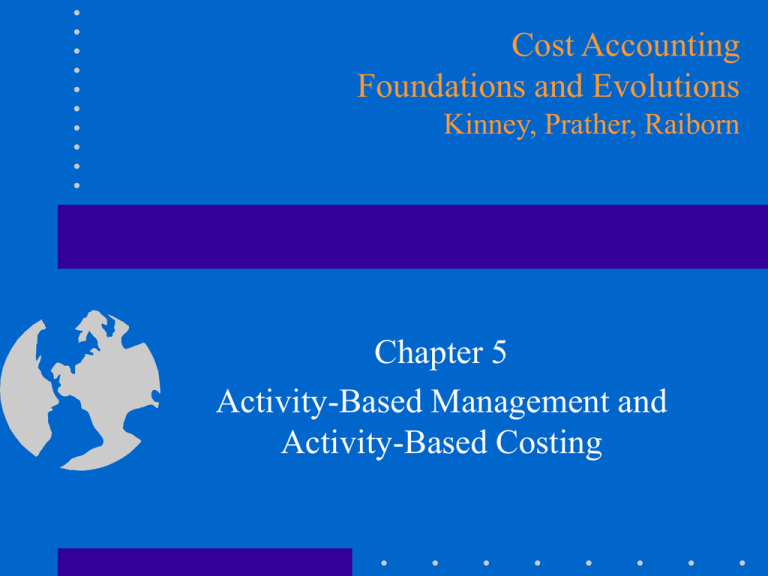
Cost Accounting Foundations and Evolutions Kinney, Prather, Raiborn Chapter 5 Activity-Based Management and Activity-Based Costing Learning Objectives (1 of 2) • Identify the focus of activity-based management • Explain why non-value-added activities cause costs to increase unnecessarily • Explain why cost drivers are designated in activity-based costing Learning Objectives (2 of 2) • Contrast activity-based costing to the traditional cost accounting system • Describe the types of information provided by an activity-based costing/management system • Explain when it is appropriate to use activity-based costing Activity-Based Management • Focuses on activities during production and performance process • Improves the value received by customers • Enhances profitability Activity An activity is a repetitive action performed in fulfillment of a business function Activity-Based Management Activity analysis Cost driver analysis Activity-based costing Continuous improvement Operational control Quality management Business process improvement Performance measurement ABM Activity Based Management • External Benefits – Increased customer value – Enhanced profitability • Internal Benefits – More efficient production – More accurate cost determination – More effective performance evaluation ABM Activity Analysis Non-value-added activity • Increases time spent on Value-added activity product or service but does • Increases worth of not increase worth product or service to a • Unnecessary from customer customer perspective • Customer is willing to • Can be reduced, redesigned pay for it or eliminated without affecting market value or quality • Business-value-added activities are essential Process • A process is a series of activities that, when performed together, satisfy a specific objective – – – – Production Distribution Selling Administration ABM Activity Analysis • Create a Process Map (detailed flowchart) for each process – Identify each step ABM Activity Analysis • Create a Process Map (detailed flowchart) for each process – Identify each step • Create Value Chart – Identify stages and time spent in stages from beginning to end of process Value-Added Processing Time Service Time Non-Value-Added Inspection Time Transfer Time Idle Time Cycle Time Cycle Time = ValueAdded + Activities NonValue-Added Activities Eliminate or minimize activities that add the most time and cost and the least value Manufacturing Cycle Efficiency Manufacturing Cycle Efficiency (MCE) = Value-Added Processing Time Total Cycle Time Manufacturing Cycle Efficiency Manufacturing Cycle Efficiency (MCE) = Value-Added Processing Time Total Cycle Time • 100% efficiency unrealistic • Reducing non-value-added activities will increase Manufacturing Cycle Efficiency • Value-added activity usually represents about 10% of total cycle time • Just-in-time (JIT) increases MCE Non-Value-Added Activities • Attributed to following factors – Systemic – Physical – Human • Eliminating or reducing non-value-added activities that create the most costs will – Increase product/service quality – Decrease cycle time and cost ABM Cost Driver Analysis • Cost drivers are factors that have a direct cause-effect relationship to a cost – Limit the number of cost drivers – Cost of measurement should not exceed benefit of using the cost driver – Easy to understand – Directly related to activity being performed – Appropriate for measurement A Management Tool Combine • Activity analysis – What activities are non-value-added? • Cost driver analysis – What causes costs to be incurred? ABM Cost Driver Analysis • Unit-level costs – direct material, direct labor • Batch-level costs – setup, inspection • Product/process-level costs – engineering changes, product development • Organizational or facility costs – building depreciation, plant manager’s salary Product Cost Behavior • Unit-level costs are variable in relation to change in production volume • Batch, product/process, and organizational level costs are variable for reasons other than changes in production volume Product Cost Unit-Level Costs Allocate over number of units produced Cost per unit Batch-Level Costs Allocate over number of units in batch Cost per unit in batch Product/ProcessLevel Costs Allocate over number of units produced in related product line Cost per unit in product line For each product line Product and Company Profitability Unit Batch Product Total product revenue <Total product cost> Net product margin <Organizational/facility-level costs> Company profit or loss Not GAAP ABM Activity-Based Costing • Recognizes several levels of costs • Accumulates costs into related cost pools • Uses multiple cost drivers to assign costs to products and services When to Use ABC Companies use ABC when • They have a wide variety of products or services • High overhead costs are not proportional to the unit volume of individual products • Automation makes it difficult to assign overhead to products using direct labor or machine hours • Profit margins are difficult to explain • Hard-to-make products show big profits and easy-tomake products show losses Two-Step Allocation • Collect costs in general ledger and subsidiary accounts • Identify activity centers Choosing an Activity Center • Geographical proximity of equipment • Centers of managerial responsibility • Magnitude of product costs Choose a manageable number of activity centers Two-Step Allocation • Collect costs in general ledger and subsidiary accounts • Identify activity centers • Accumulate costs into activity center cost pools – Identify cost drivers ABC Cost Pools Assumptions about activity center cost pools • Costs in each cost pool are – Driven by homogenous activities – Strictly proportional to the activity Two-Step Allocation • Collect costs in general ledger and subsidiary accounts • Identify activity centers • Accumulate costs into activity center cost pools – cost drivers • Allocate costs to products and services – activity driver measures demands placed on activities, thus, the resources consumed by products/services Activity Drivers • • • • • • • Reports requested Job change actions Hiring actions Training hours Transactions processed Engineering changes Defects discovered • • • • • • • Repair hours Material requisitions Purchase requisitions Space occupied Set-ups Moves Employees Traditional vs. ABC Costing • When ABC implemented – Cost reduced for high volume, standard products – Cost increased for low-volume, complex specialty products Long-Term Variable Costs • Cost drivers – Product variety – number of different types of products – Product complexity – number of processes through which a product flows ABM ABC Costing Considerations • Number and diversity of products/services produced • Diversity and differential degree of support services used for different products • Extent to which common processes are used • Effectiveness of current cost allocation methods • Rate of growth of period costs ABM Use ABC Costing when…. 1. 2. 3. 4. Product Variety and Process Complexity Lack of Commonality in Overhead Costs Problems with Current Cost Allocations Changes in Business Environment ABM Use ABC Costing when…. 1. Product Variety and Process Complexity – Caused by mass customization • Too many choices, opportunity for errors • Pareto Principle • Commonality of parts – Reduced by • Simultaneous (or Concurrent) Engineering • Design for Manufacturability ABM Use ABC Costing when…. 2. Lack of Commonality in Overhead Costs - Some products/services use substantially more overhead than others 3. Problems with Current Cost Allocations - - Significant changes in process with no change in cost allocations Expense majority of period costs when incurred ABM Use ABC Costing when…. 4. Changes in Business Environment – – Increase in competition Change in management strategy ABM Continuous Improvement • Eliminates non-value-added activities to reduce cycle time • Makes products/performs services with zero defects • Reduces product costs on an ongoing basis • Simplifies products and processes ABC Costing Supports Continuous Improvement Criticisms of ABC • Significant amount of time and cost to implement • Must overcome barriers to change • Does not conform to GAAP • May not promote total quality management ABM Advantages of ABC and ABM • Identify and monitor significant technology costs • Trace technology costs directly to products • Identify the cost drivers that create or influence cost • Identify activities that do not contribute to perceived customer value ABM Advantages of ABC and ABM • Illustrate the impact of new technologies on all elements of performance • Translate company goals into activity goals • Analyze the performance of activities across business functions • Analyze performance problems • Promote standards of excellence Questions • What are the differences between activitybased costing and traditional cost accounting? • What are cost drivers and activity drivers? • What are two advantages and two criticisms of activity-based costing?
